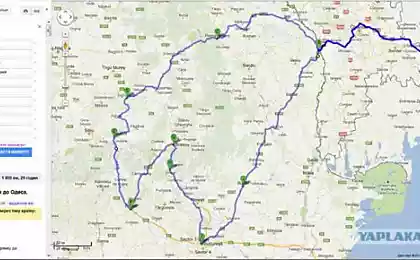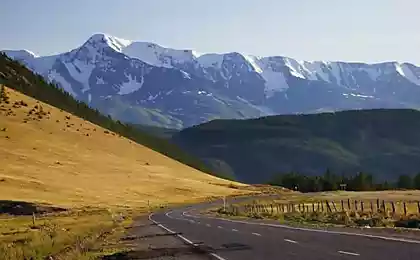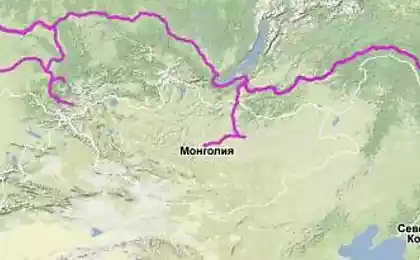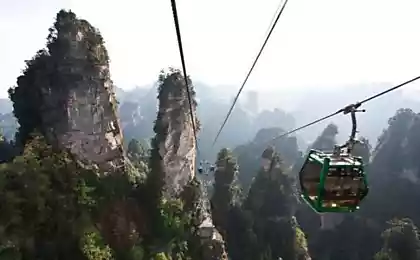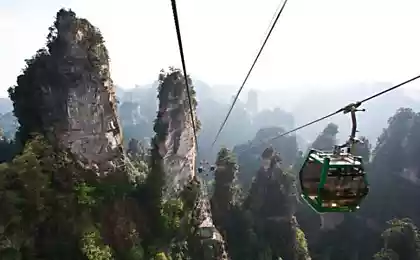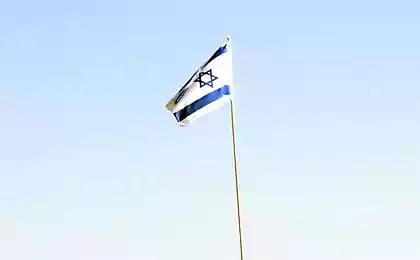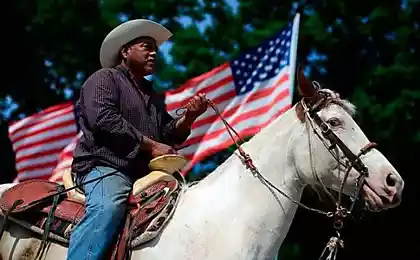1450
The house is on the road (17 photos + video)
In the north of Manhattan, it is one of the most controversial residential complexes in New York, entitled "Bridge Apartments." The point here is not in the architectural solutions - it looks quite ordinary four high-rise buildings. The problem is its location - it is just above Highway Transmanhetten-Expressway - one of the busiest transportation roads not only in the US but also in the world. The huge transport interchange linking the George Washington Bridge to Manhattan and the Bronx, a quarter of a million cars and trucks passing here every day, constant noise, exhaust fumes, vibration, and right above it all home to more than 4000 people. Can you imagine a more unfortunate place for housing?
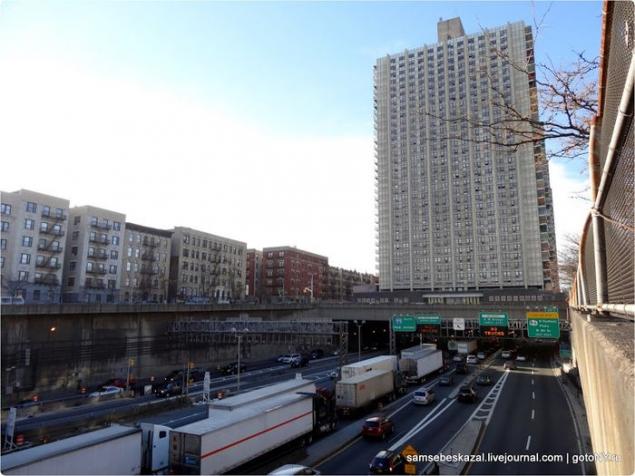
In 1962 he opened a new 12-way stretch of road length of 2, 22 km, linking the who in the same year, bunk George Washington Bridge to the highway Cross Bronx Expressway. This small area has been a major element in the newly built Robert Moses new transport corridor, designed to take cargo and transit traffic from the lower and middle parts of Manhattan. Transmanhetten-ekspressvey included several new interchanges and became one of the key transport infrastructure of the city. As this was one of the first attempts in the US to use the space on the highway. In a small area above the road was built a new bus station and a residential complex consisting of four 32-storey buildings.

In 1960, the Port Authority of New York and New Jersey, the city transferred the right of the air over the area near the George Washington Bridge. The town sold it at auction for $ 1 million Kratter korporeyshen company, which decided to develop land within the Mitchell-Lama program to build housing for the middle class. Construction began in 1961 and it was one of the first high-rise buildings lined with aluminum. Three years later, in a residential complex began to take root first lucky owners of new apartments.
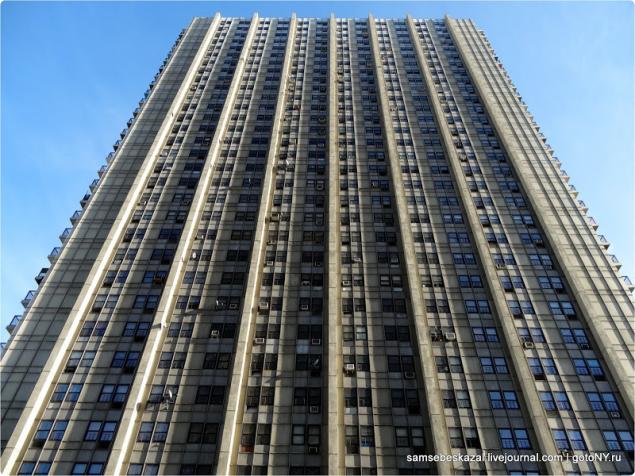
The complex had to turn deprived areas inhabited by people of low income in the place attractive for the middle class, and become the first positive experience in the development of space above the high-speed highways. Then the question vengeance stirred up the minds of American urban planners, but all attempts to implement a similar project was hampered by the same problem - the high level of air pollution over the road. In order to attract the middle class used the economic mechanism in the form of subsidized loans for buying property in the complex. Air pollution problems have been solved with the help of architects, designers and engineers worked on the project. To this end, the company attracted Brown & Guenther, who offered to build four buildings with central ventilation and facades lined with aluminum panels for the rejection of soot and combustion products remaining in the exhaust gases.
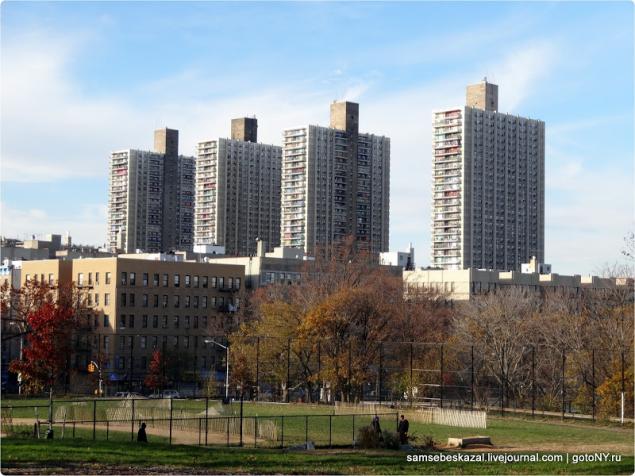
Four 240-apartment building called none other than "the most amazing opportunity for a great New York families" and residents have promised "the most luxurious of the available money." Four-room apartment cost $ 179 per month including all services. On the lower floors were equipped laundry and utility rooms. Near the metro station. At the bottom of a multi-level parking for tenants.

But the fairy tale did not come true. Almost immediately it became clear that neither noise nor the purity of the air in the rooms do not meet the standards.
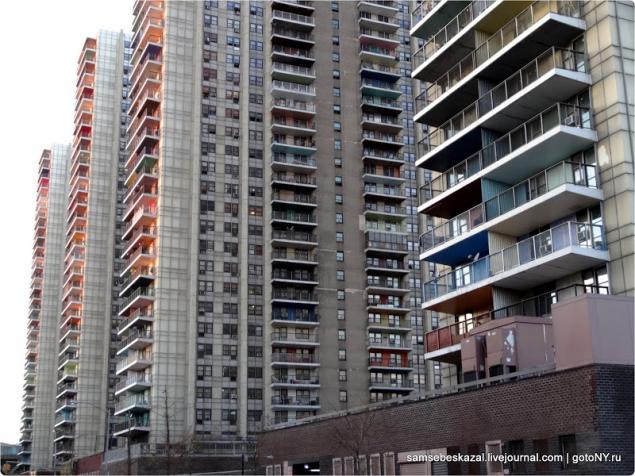
In 1967, Robert Kennedy during a visit to a residential complex, said that "the choice of location for the construction of houses on top of one of the busiest highways in New York, shows a complete disregard for the environmental factors on the part of planners and city authorities." Five years later, the tenants went on strike because of the deteriorating living conditions.
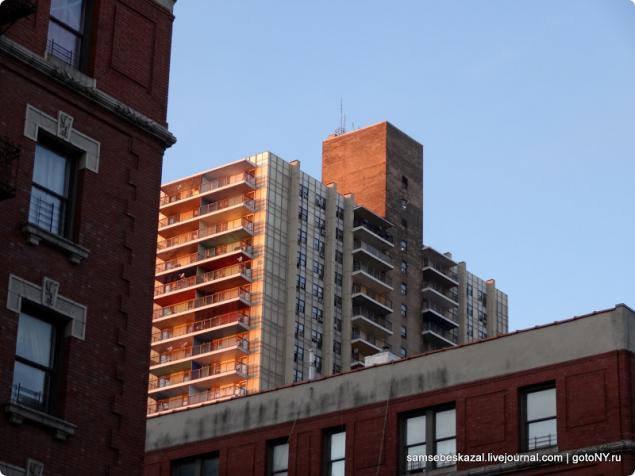
In 1987 the building changed owners, and finally dissolved in the environment. Prospective housing for the middle class turned into another apartment complex for residents. And it is mainly populated by low-income immigrants from the Dominican Republic.
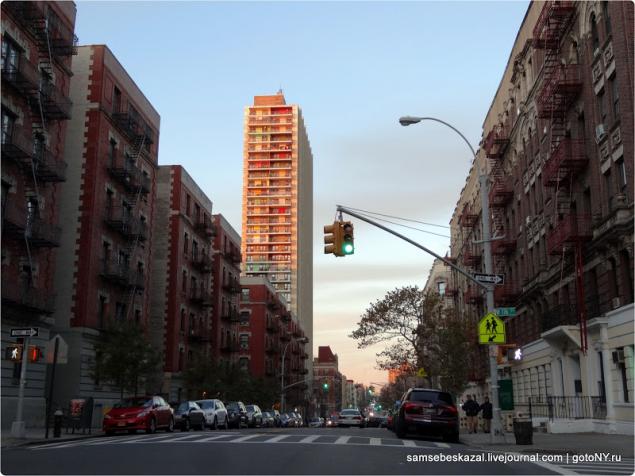
The reality is that the ventilation system can not cope, and tenants have to keep the windows open, but the wind picks up the exhaust gases along the facade up to the upper floors, and they get into an apartment. With the windows closed in the apartments can not breathe, and residents have to install their own window air conditioners. Because the exhaust gas as it is impossible to really enjoy the balcony.
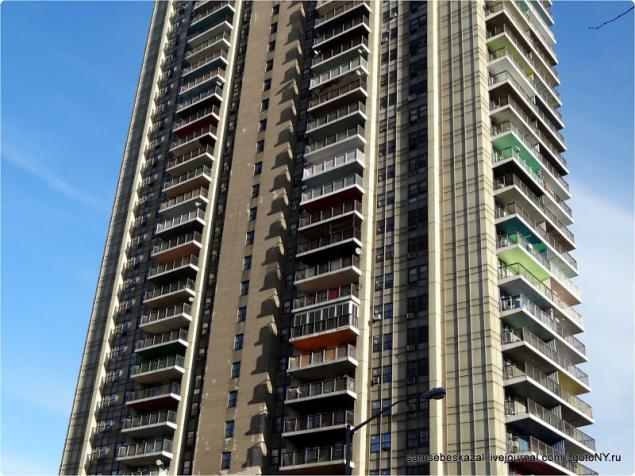
In the lower and middle floors of the buildings can not talk with the windows open without raising his voice. Because of the high load line is the noise under the windows clock.
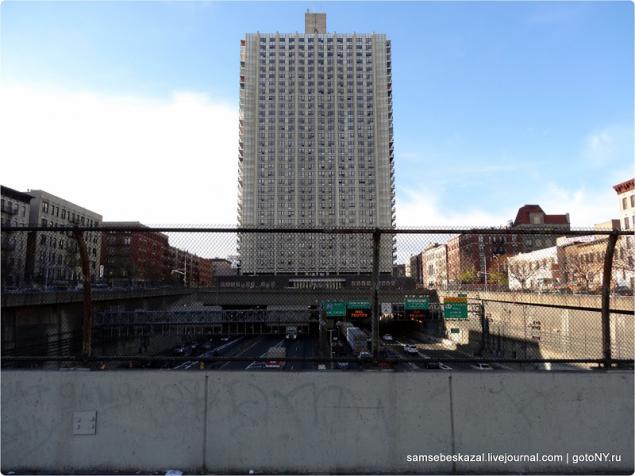
Heavy trucks creates vibration that is felt inside the building.
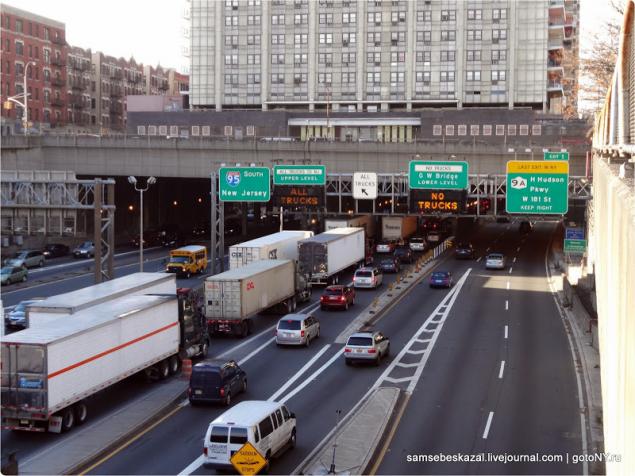
Many of the apartments have undergone illegal redevelopment and turned into an analogue of the Soviet communal apartments, rooms in which relieve the poorest residents of the area. From the great room make two or three small, even manage to compact kitchens.
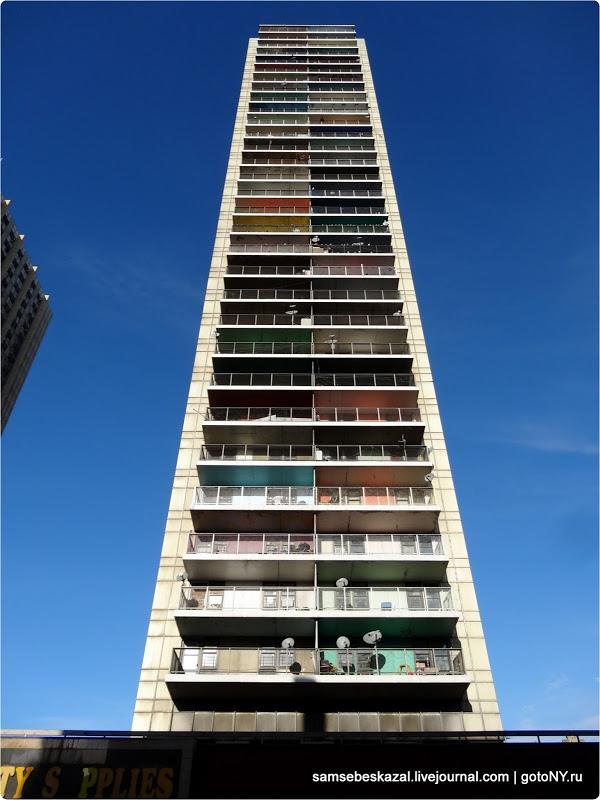
In order to somehow improve the atmosphere, extreme tenants paint their apartment balconies in bright colors.
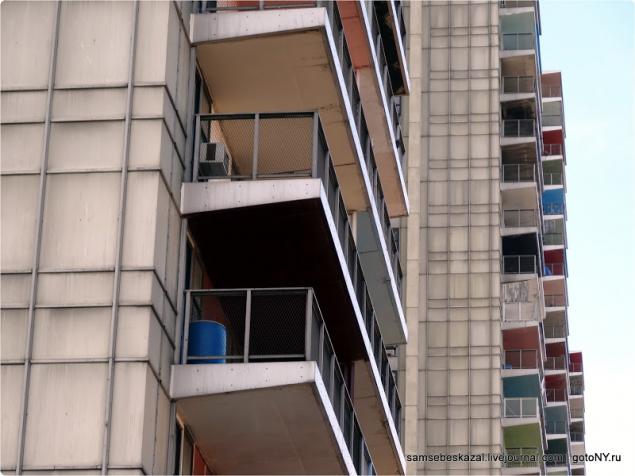
The halls and corridors are dilapidated buildings, and only complete the picture of complete despondency.
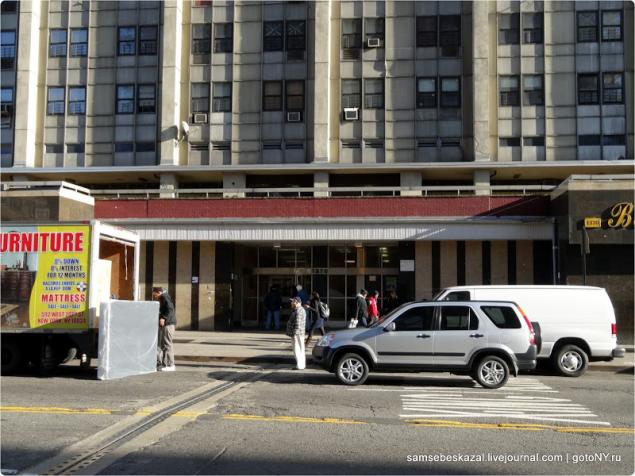
But tepr no one complains about the exhaust gases and the noise level, not satisfied with pickets and crosses the city government complaints.

The complex is adjacent bus station was built in 1963, was sponsored by the "poet of concrete", the Italian Pier Luigi Nervi. The station has an original design and a special ventilation system.

On two levels, there are 24 bus platforms. Every day, they are 17,000 passengers come and go on 950 buses. This year, the bus going to reconstruct.
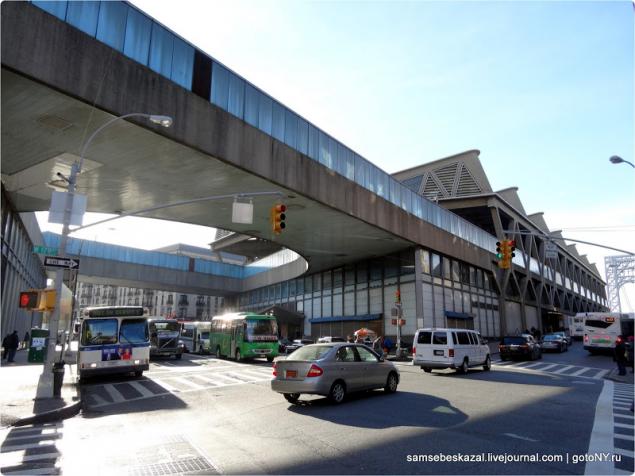
Video Directions for houses (first minute).
Source: samsebeskazal.livejournal.com

In 1962 he opened a new 12-way stretch of road length of 2, 22 km, linking the who in the same year, bunk George Washington Bridge to the highway Cross Bronx Expressway. This small area has been a major element in the newly built Robert Moses new transport corridor, designed to take cargo and transit traffic from the lower and middle parts of Manhattan. Transmanhetten-ekspressvey included several new interchanges and became one of the key transport infrastructure of the city. As this was one of the first attempts in the US to use the space on the highway. In a small area above the road was built a new bus station and a residential complex consisting of four 32-storey buildings.

In 1960, the Port Authority of New York and New Jersey, the city transferred the right of the air over the area near the George Washington Bridge. The town sold it at auction for $ 1 million Kratter korporeyshen company, which decided to develop land within the Mitchell-Lama program to build housing for the middle class. Construction began in 1961 and it was one of the first high-rise buildings lined with aluminum. Three years later, in a residential complex began to take root first lucky owners of new apartments.

The complex had to turn deprived areas inhabited by people of low income in the place attractive for the middle class, and become the first positive experience in the development of space above the high-speed highways. Then the question vengeance stirred up the minds of American urban planners, but all attempts to implement a similar project was hampered by the same problem - the high level of air pollution over the road. In order to attract the middle class used the economic mechanism in the form of subsidized loans for buying property in the complex. Air pollution problems have been solved with the help of architects, designers and engineers worked on the project. To this end, the company attracted Brown & Guenther, who offered to build four buildings with central ventilation and facades lined with aluminum panels for the rejection of soot and combustion products remaining in the exhaust gases.

Four 240-apartment building called none other than "the most amazing opportunity for a great New York families" and residents have promised "the most luxurious of the available money." Four-room apartment cost $ 179 per month including all services. On the lower floors were equipped laundry and utility rooms. Near the metro station. At the bottom of a multi-level parking for tenants.

But the fairy tale did not come true. Almost immediately it became clear that neither noise nor the purity of the air in the rooms do not meet the standards.

In 1967, Robert Kennedy during a visit to a residential complex, said that "the choice of location for the construction of houses on top of one of the busiest highways in New York, shows a complete disregard for the environmental factors on the part of planners and city authorities." Five years later, the tenants went on strike because of the deteriorating living conditions.

In 1987 the building changed owners, and finally dissolved in the environment. Prospective housing for the middle class turned into another apartment complex for residents. And it is mainly populated by low-income immigrants from the Dominican Republic.

The reality is that the ventilation system can not cope, and tenants have to keep the windows open, but the wind picks up the exhaust gases along the facade up to the upper floors, and they get into an apartment. With the windows closed in the apartments can not breathe, and residents have to install their own window air conditioners. Because the exhaust gas as it is impossible to really enjoy the balcony.

In the lower and middle floors of the buildings can not talk with the windows open without raising his voice. Because of the high load line is the noise under the windows clock.

Heavy trucks creates vibration that is felt inside the building.

Many of the apartments have undergone illegal redevelopment and turned into an analogue of the Soviet communal apartments, rooms in which relieve the poorest residents of the area. From the great room make two or three small, even manage to compact kitchens.

In order to somehow improve the atmosphere, extreme tenants paint their apartment balconies in bright colors.

The halls and corridors are dilapidated buildings, and only complete the picture of complete despondency.

But tepr no one complains about the exhaust gases and the noise level, not satisfied with pickets and crosses the city government complaints.

The complex is adjacent bus station was built in 1963, was sponsored by the "poet of concrete", the Italian Pier Luigi Nervi. The station has an original design and a special ventilation system.

On two levels, there are 24 bus platforms. Every day, they are 17,000 passengers come and go on 950 buses. This year, the bus going to reconstruct.

Video Directions for houses (first minute).
Source: samsebeskazal.livejournal.com


